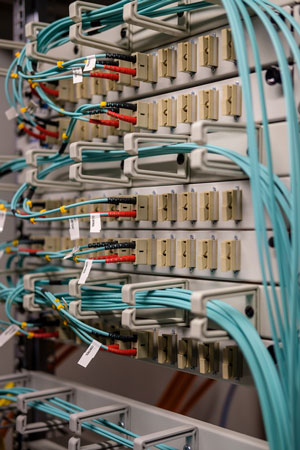High bandwidth fiber optic Wide Area Networks have their basis in a decades old telephone company standard called SONET. Highly reliable, but highly expensive, SONET is giving way to the newer technology of Ethernet WAN. As demand for business bandwidth keeps increasing, so does the attractiveness of Ethernet for long distance connections.
 Why SONET Ruled For So Long
Why SONET Ruled For So LongSONET or Synchronous Optical Network was born out of a burgeoning demand for higher and higher levels of traffic. In this case, the traffic was long distance telephone calls. In the early days of telephony, this demand was met with dense webs of overhead copper lines.
Multi-channel analog technology made it possible for each copper pair to carry many phone conservations on a carrier-based system, much like many radio stations in a single band.
Digital technology eliminated the noise and crosstalk of carrier telephony by converting the analog conversations to pulse coded digital streams and multiplexing many together on a single pair. The transmission medium was still copper wire.
One thing about phone company standards is that they are all backwards compatible down to a single phone line. After all, that’s the telco business. So, the digital T1 lines were actually carrying 24 separate phone calls. A T3 line was 28 T1 lines or 672 phone calls.
When the fiber optic standard was developed, it picked up where copper left off. The OC3 SONET line is 155 Mbps and is equivalent to three T3 lines. Within all those multiplexed channels is the same 64 Kbps voice channel to support one phone call.
How did we get from really big phone lines to data transmission? Basically, SONET was the only game in town if you needed large amounts of bandwidth. So, all those voice channels in the line were combined to create one large data channel to carry packets of information. That requires protocol conversion circuitry to go from Ethernet network protocol to SONET telephone line protocol.
This works beautifully, but there are a few issues. For one thing, SONET levels are very specific and not scalable. If you want to move up from, say, a 155 Mbps OC3 to a 622 Mbps OC-12, you’ll at least need to swap out the termination controller or interface card in your router. Also, since analog phone traffic is now trivial compared to packet based data traffic, wouldn’t it be more efficient to just keep everything Ethernet from end to end? Indeed, it would.
Ethernet Replacements For SONET Most competitive carriers and even many of the traditional telecom companies have adopted Ethernet as their network standard, as that’s where the traffic is. As a result, you can find much better pricing for Ethernet circuits than for traditional SONET. Ethernet WAN is also highly scalable. If you install a Gigabit Ethernet port, you can order service at any bandwidth level up to 1 Gbps. That covers OC-3 at 155 Mbps, OC-12 at 622 Mbps and pretty much OC-24 at 1.2 Gbps.
No hardware changes are needed until you require more 1 Gbps. At that point you may install a 10 Gbps port which will cover OC-24, plus OC-48 at 2.5 Gbps and OC-192 at 10 Gbps. Today, 100 Gbps is becoming more and more available to take the place of OC-768 at 40 Gbps.
If you are looking to upgrade your fiber optic WAN connections or are just curious about how much you might save by switching from SONET to Ethernet WAN service, you can easily get a set of competitive quotes from multiple service providers with no obligation. That applies to private line services, including cloud communications, as well as dedicated Internet access. Now would be a good time to make that inquiry.

